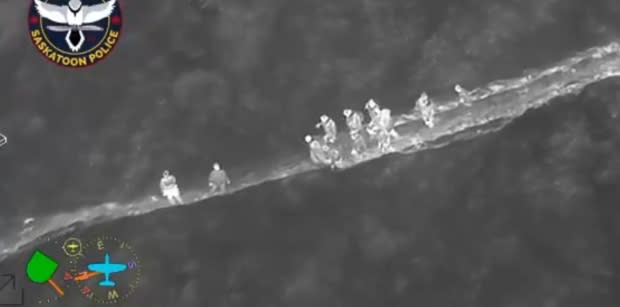'It almost makes you cry': Police pilot reveals how technology helped find lost visually impaired man
Saskatoon police Sgt. Wade Bourassa and Const. Christina Holovach had spent the last 45 minutes scouring 50 square kilometres of ground from their Cessna police plane looking for a missing 66-year-old man from North Battleford, Sask.
They were searching for Gordon Bingham, 66, who was reported missing last Monday after leaving his home around 7 a.m. CST.
Bingham is legally blind, and police were called when he did not return home.
Bourassa, who pilots the Saskatoon Police Service plane, got a call that evening to join the search for Bingham.

Equipped with a $500,000 thermal imaging camera system, they started searching an area north of the city.
"We were searching the fields, the treed areas and all of that sort of stuff," Bourassa said.
They saw all kinds of wildlife activity, but no human showed up on the infrared screen that Holovach was using.

But the state-of-the-art equipment records exactly where they searched, and revealed there was a small area that they had missed.
"When we started searching that small little pocket is when we noticed a hot spot in a wooded area," Bourassa said.
It resembled a human, and when they adjusted the camera settings they could see footprints going across the field in a circular pattern.
They directed a ground team to the spot where they found Bingham, still alive despite having been outside for nearly 15 hours in temperatures that felt like –34 with the wind chill.
After he was found, Bingham was taken to hospital, where he was treated for hypothermia and frostbite-related injuries.
"The moment of that first radio transmission saying, 'We've located the person, send EMS, he's talking to us' — it almost makes you cry," Bourassa said of helping in Bingham's rescue.
"It is a career highlight."
He credits Holovach with her great work operating the infrared equipment.

"It's kind of like being a fly on the wall," he said. "I get to see what she is doing. I get to hear what she's doing, and at the end of the day it's very fulfilling to see everything play out right before my eyes.
"What I'm watching is simply magic. It's extraordinary."
Bourassa said the Saskatoon police plane spends about 1,200 hours in the air over the city each year and responds to about 1,300 calls.
They also assist the RCMP about 50 times a year, most often for search-and-rescue missions.
He said it's great when they help catch a criminal, but saving a life is special.
"When it is successful like this it is a lot more satisfying."

